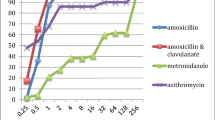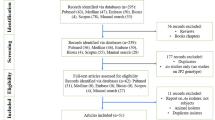Abstract
Objectives
Aggregatibacter actinomycetemcomitans strains of serotype b and with a deletion of 530 bp in the promoter region of the leukotoxin gene (JP2 clone) are known to be associated with severe periodontitis. Our study was aimed to detect virulence genes of A. actinomycetemcomitans strains obtained from patients living in four German cities with different proportions of immigrants.
Material and methods
Samples were obtained from severe periodontitis patients in Frankfurt, Hamburg, Leipzig, and Jena. Those being tested positive for A. actinomycetemcomitans were analyzed for serotypes, deletion in the promoter region of the leukotoxin gene, presence of cytolethal distending toxin encoding genes (cdtA, cdtB, and cdtC) and fibril gene1(flp-1).
Results
From all 99 A. actinomycetemcomitans-positive samples, the JP2 clone was found in two immigrants in Frankfurt. Seventy strains were tested positive for the cdtA, 52 for cdtB, and 92 for cdtC and flp-1 genes. Twenty-five strains belonged to serotype a, 22 to serotype b, 21 to serotype c, 31 to the others or could not be serotyped, respectively. The distribution of the serotypes differed between the cities. Further, differences regarding the serotypes were also significant between natives and immigrants.
Conclusions
The JP2 clone is not spread within the Caucasian inhabitants in German cities. The serotypes distribution seems to be influenced by the numbers of immigrants in the cities.
Clinical Relevance
Patients originated from North Africa should be especially screened for the presence of the deletion in the ltx promoter region.


Similar content being viewed by others
References
Holtfreter B, Schwahn C, Biffar R, Kocher T (2009) Epidemiology of periodontal diseases in the study of health in Pomerania. J Clin Periodontol 36:114–23
Henderson B, Ward JM (2000) Ready D (2010) Aggregatibacter (Actinobacillus) actinomycetemcomitans: a triple A* periodontopathogen? Periodontol 54:78–105
Saarela M, Asikainen S, Alaluusua S, Pyhala L, Lai CH, Jousimies-Somer H (1992) Frequency and stability of mono- or poly-infection by Actinobacillus actinomycetemcomitans serotypes a, b, c, d or e. Oral Microbiol Immunol 7:277–9
Kaplan JB, Schreiner HC, Furgang D, Fine DH (2002) Population structure and genetic diversity of Actinobacillus actinomycetemcomitans strains isolated from localized juvenile periodontitis patients. J Clin Microbiol 40:1181–7
Lakio L, Paju S, Alfthan G, Tiirola T, Asikainen S, Pussinen PJ (2003) Actinobacillus actinomycetemcomitans serotype d-specific antigen contains the O antigen of lipopolysaccharide. Infect Immun 71:5005–11
Socransky SS, Haffajee AD, Smith C, Dibart S (1991) Relation of counts of microbial species to clinical status at the sampled site. J Clin Periodontol 18:766–75
Kawamoto D, Ando ES, Longo PL, Nunes AC, Wikstrom M, Mayer MP (2009) Genetic diversity and toxic activity of Aggregatibacter actinomycetemcomitans isolates. Oral Microbiol Immunol 24:493–501
Kieba IR, Fong KP, Tang HY, Hoffman KE, Speicher DW, Klickstein LB, Lally ET (2007) Aggregatibacter actinomycetemcomitans leukotoxin requires beta-sheets 1 and 2 of the human CD11a beta-propeller for cytotoxicity. Cell Microbiol 9:2689–99
Balashova NV, Shah C, Patel JK, Megalla S, Kachlany SC (2009) Aggregatibacter actinomycetemcomitans LtxC is required for leukotoxin activity and initial interaction between toxin and host cells. Gene 443:42–7
Brogan JM, Lally ET, Poulsen K, Kilian M, Demuth DR (1994) Regulation of Actinobacillus actinomycetemcomitans leukotoxin expression: analysis of the promoter regions of leukotoxic and minimally leukotoxic strains. Infect Immun 62:501–8
Haubek D, Poulsen K, Westergaard J, Dahlen G, Kilian M (1996) Highly toxic clone of Actinobacillus actinomycetemcomitans in geographically widespread cases of juvenile periodontitis in adolescents of African origin. J Clin Microbiol 34:1576–8
Mayer MP, Bueno LC, Hansen EJ, DiRienzo JM (1999) Identification of a cytolethal distending toxin gene locus and features of a virulence-associated region in Actinobacillus actinomycetemcomitans. Infect Immun 67:1227–37
Akifusa S, Heywood W, Nair SP, Stenbeck G, Henderson B (2005) Mechanism of internalization of the cytolethal distending toxin of Actinobacillus actinomycetemcomitans. Microbiology 151:1395–402
Oscarsson J, Karched M, Thay B, Chen C, Asikainen S (2008) Proinflammatory effect in whole blood by free soluble bacterial components released from planktonic and biofilm cells. BMC Microbiol 8:206
Shenker BJ, Besack D, McKay T, Pankoski L, Zekavat A, Demuth DR (2005) Induction of cell cycle arrest in lymphocytes by Actinobacillus actinomycetemcomitans cytolethal distending toxin requires three subunits for maximum activity. J Immunol 174:2228–34
Shenker BJ, Dlakic M, Walker LP, Besack D, Jaffe E, LaBelle E, Boesze-Battaglia K (2007) A novel mode of action for a microbial-derived immunotoxin: the cytolethal distending toxin subunit B exhibits phosphatidylinositol 3,4,5-triphosphate phosphatase activity. J Immunol 178:5099–108
Shenker BJ, Besack D, McKay T, Pankoski L, Zekavat A, Demuth DR (2004) Actinobacillus actinomycetemcomitans cytolethal distending toxin (Cdt): evidence that the holotoxin is composed of three subunits: CdtA, CdtB, and CdtC. J Immunol 172:410–7
Cao L, Volgina A, Huang CM, Korostoff J, DiRienzo JM (2005) Characterization of point mutations in the cdtA gene of the cytolethal distending toxin of Actinobacillus actinomycetemcomitans. Mol Microbiol 58:1303–21
Kaplan JB, Meyenhofer MF, Fine DH (2003) Biofilm growth and detachment of Actinobacillus actinomycetemcomitans. J Bacteriol 185:1399–404
Tomich M, Fine DH, Figurski DH (2006) The TadV protein of Actinobacillus actinomycetemcomitans is a novel aspartic acid prepilin peptidase required for maturation of the Flp1 pilin and TadE and TadF pseudopilins. J Bacteriol 188:6899–914
Planet PJ, Kachlany SC, Fine DH, DeSalle R, Figurski DH (2003) The widespread colonization island of Actinobacillus actinomycetemcomitans. Nat Genet 34:193–8
Kachlany SC, Planet PJ, Desalle R, Fine DH, Figurski DH, Kaplan JB (2001) flp-1, the first representative of a new pilin gene subfamily, is required for non-specific adherence of Actinobacillus actinomycetemcomitans. Mol Microbiol 40:542–54
Armitage GC (1999) Development of a classification system for periodontal diseases and conditions. Ann Periodontol 4:1–6
O'Leary TJ, Drake RB, Naylor JE (1972) The plaque control record. J Periodontol 43:38
Beikler T, Schnitzer S, Abdeen G, Ehmke B, Eisenacher M, Flemmig TF (2006) Sampling strategy for intraoral detection of periodontal pathogens before and following periodontal therapy. J Periodontol 77:1323–32
Tran SD, Rudney JD (1999) Improved multiplex PCR using conserved and species-specific 16S rRNA gene primers for simultaneous detection of Actinobacillus actinomycetemcomitans, Bacteroides forsythus, and Porphyromonas gingivalis. J Clin Microbiol 37:3504–8
Fabris AS, DiRienzo JM, Wikstrom M, Mayer MP (2002) Detection of cytolethal distending toxin activity and cdt genes in Actinobacillus actinomycetemcomitans isolates from geographically diverse populations. Oral Microbiol Immunol 17:231–8
Kaplan JB, Kokeguchi S, Murayama Y, Fine DH (2002) Sequence diversity in the major fimbrial subunit gene (flp-1) of Actinobacillus actinomycetemcomitans. Oral Microbiol Immunol 17:354–9
Federal Statistical Office G (2010) Available at http://www.destatis.de/jetspeed/portal/cms/Sites/destatis/Internet/DE/Navigation/Statistiken/Bevoelkerung/Bevoelkerung.psml
Haubek D, Ennibi OK, Poulsen K, Vaeth M, Poulsen S, Kilian M (2008) Risk of aggressive periodontitis in adolescent carriers of the JP2 clone of Aggregatibacter (Actinobacillus) actinomycetemcomitans in Morocco: a prospective longitudinal cohort study. Lancet 371:237–42
Macheleidt A, Muller HP, Eger T, Putzker M, Fuhrmann A, Zoller L (1999) Absence of an especially toxic clone among isolates of Actinobacillus actinomycetemcomitans recovered from army recruits. Clin Oral Investig 3:161–7
Fine DH, Markowitz K, Furgang D, Fairlie K, Ferrandiz J, Nasri C, McKiernan M, Gunsolley J (2007) Aggregatibacter actinomycetemcomitans and its relationship to initiation of localized aggressive periodontitis: longitudinal cohort study of initially healthy adolescents. J Clin Microbiol 45:3859–69
Sakellari D, Katsikari A, Slini T, Ioannidis I, Konstantinidis A, Arsenakis M (2011) Prevalence and distribution of Aggregatibacter actinomycetemcomitans serotypes and the JP2 clone in a Greek population. J Clin Periodontol 38:108–14
Claesson R, Lagervall M, Hoglund-Aberg C, Johansson A, Haubek D (2011) Detection of the highly leucotoxic JP2 clone of Aggregatibacter actinomycetemcomitans in members of a Caucasian family living in Sweden. J Clin Periodontol 38:115–21
Tan KS, Woo CH, Ong G, Song KP (2001) Prevalence of Actinobacillus actinomycetemcomitans in an ethnic adult Chinese population. J Clin Periodontol 28:886–90
Mombelli A, Gmur R, Lang NP, Corbert E, Frey J (1999) Actinobacillus actinomycetemcomitans in Chinese adults. Serotype distribution and analysis of the leukotoxin gene promoter locus. J Clin Periodontol 26:505–10
Cortelli SC, Jorge AO, Cortelli JR, Jordan SF, Haraszthy VI (2003) Detection of highly and minimally leukotoxic Actinobacillus actinomycetemcomitans strains in patients with periodontal disease. Pesqui Odontol Bras 17:183–8
Vieira EM, Raslan SA, Wahasugui TC, Avila-Campos MJ, Marvulle V, Gaetti-Jardim Junior E (2009) Occurrence of Aggregatibacter actinomycetemcomitans in Brazilian Indians from Umutina Reservation, Mato Grosso, Brazil. J Appl Oral Sci 17:440–5
Factbook TW (2011) Available at https://www.cia.gov/library/publications/the-world-factbook/geos/br.html
Yang HW, Huang YF, Chan Y, Chou MY (2005) Relationship of Actinobacillus actinomycetemcomitans serotypes to periodontal condition: prevalence and proportions in subgingival plaque. Eur J Oral Sci 113:28–33
Kim TS, Frank P, Eickholz P, Eick S, Kim CK (2009) Serotypes of Aggregatibacter actinomycetemcomitans in patients with different ethnic backgrounds. J Periodontol 80:2020–7
Takada K, Saito M, Tsuzukibashi O, Kawashima Y, Ishida S, Hirasawa M (2010) Characterization of a new serotype g isolate of Aggregatibacter actinomycetemcomitans. Mol Oral Microbiol 25:200–6
Zambon JJ, Christersson LA, Slots J (1983) Actinobacillus actinomycetemcomitans in human periodontal disease. Prevalence in patient groups and distribution of biotypes and serotypes within families. J Periodontol 54:707–11
DiRienzo JM, Slots J (1990) Genetic approach to the study of epidemiology and pathogenesis of Actinobacillus actinomycetemcomitans in localized juvenile periodontitis. Arch Oral Biol 35(Suppl):79S–84S
Ahmed HJ, Svensson LA, Cope LD, Latimer JL, Hansen EJ, Ahlman K, Bayat-Turk J, Klamer D, Lagergard T (2001) Prevalence of cdtABC genes encoding cytolethal distending toxin among Haemophilus ducreyi and Actinobacillus actinomycetemcomitans strains. J Med Microbiol 50:860–4
Yamano R, Ohara M, Nishikubo S, Fujiwara T, Kawamoto T, Ueno Y, Komatsuzawa H, Okuda K, Kurihara H, Suginaka H, Oswald E, Tanne K, Sugai M (2003) Prevalence of cytolethal distending toxin production in periodontopathogenic bacteria. J Clin Microbiol 41:1391–8
Leung WK, Ngai VK, Yau JY, Cheung BP, Tsang PW, Corbet EF (2005) Characterization of Actinobacillus actinomycetemcomitans isolated from young Chinese aggressive periodontitis patients. J Periodontal Res 40:258–68
Schreiner HC, Sinatra K, Kaplan JB, Furgang D, Kachlany SC, Planet PJ, Perez BA, Figurski DH, Fine DH (2003) Tight-adherence genes of Actinobacillus actinomycetemcomitans are required for virulence in a rat model. Proc Natl Acad Sci U S A 100:7295–300
Wu YM, Yan J, Chen LL, Gu ZY (2007) Association between infection of different strains of Porphyromonas gingivalis and Actinobacillus actinomycetemcomitans in subgingival plaque and clinical parameters in chronic periodontitis. J Zhejiang Univ Sci B 8:121–31
Goncharoff P, Figurski DH, Stevens RH, Fine DH (1993) Identification of Actinobacillus actinomycetemcomitans: polymerase chain reaction amplification of lktA-specific sequences. Oral Microbiol Immunol 8:105–10
Kaplan JB, Perry MB, MacLean LL, Furgang D, Wilson ME, Fine DH (2001) Structural and genetic analyses of O polysaccharide from Actinobacillus actinomycetemcomitans serotype f. Infect Immun 69:5375–84
Acknowledgments
The authors wish to thank Claudia Ranke, Hanna Loester, and Christopher Buchmann for their valuable laboratory work. Further we are grateful to Rolf Claesson (University of Umeå, Sweden) for providing us with control strains of A. actinomycetemcomitans.
Conflict of interest
Most of the study was institutionally founded. Further, this study was supported by Hain Lifescience GmbH, Nehren, Germany. The authors declare that they have no conflict of interest.
Author information
Authors and Affiliations
Corresponding author
Additional information
Holger Jentsch and Georg Cachovan contributed equally to this manuscript.
Rights and permissions
About this article
Cite this article
Jentsch, H., Cachovan, G., Guentsch, A. et al. Characterization of Aggregatibacter actinomycetemcomitans strains in periodontitis patients in Germany. Clin Oral Invest 16, 1589–1597 (2012). https://doi.org/10.1007/s00784-012-0672-x
Received:
Accepted:
Published:
Issue Date:
DOI: https://doi.org/10.1007/s00784-012-0672-x




